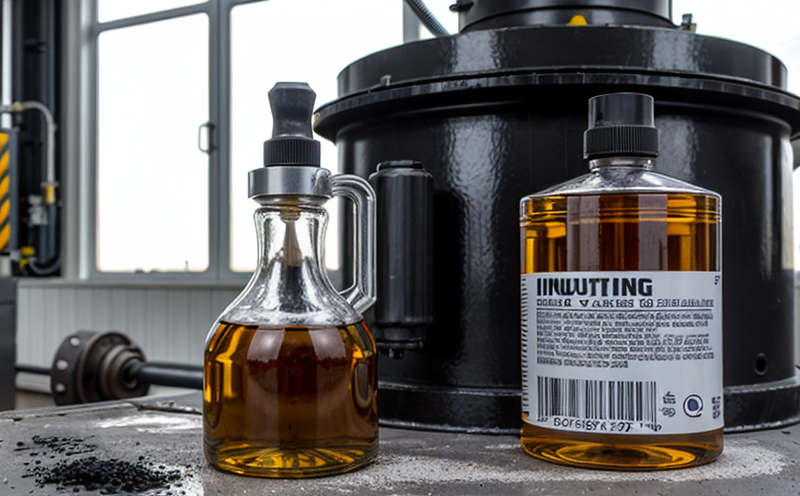ISO 13357 Filterability Testing of Hydraulic Oils
The ISO 13357 filterability testing procedure is a critical method used in the evaluation and certification of hydraulic oils. This standard provides a standardized approach to assessing how easily particles can pass through a specified filter. In industrial applications, particularly within machinery that operates under high pressure or with tight tolerances, ensuring the filterability of hydraulic oil is paramount.
The test procedure involves filtering known quantities of contaminated hydraulic oil through a specified type and size of filter under controlled conditions. The passage rate through the filter is measured over time, which provides insights into the cleanliness level of the fluid. This measurement helps in predicting the lifespan of hydraulic systems by identifying potential issues early on.
Hydraulic oils are subject to contamination from wear particles generated during operation. These contaminants can cause premature wear and failure if they are not effectively managed. By conducting ISO 13357 filterability testing, manufacturers and end-users can ensure that their hydraulic systems will perform optimally over the intended service life.
The test is particularly important for industries such as automotive, aerospace, construction, and manufacturing where efficient fluid flow is essential for maintaining system integrity. The results of this testing are used to determine if a hydraulic oil meets the cleanliness requirements specified by OEMs (Original Equipment Manufacturers) or other relevant standards like ISO 4406-1:2015.
Understanding the parameters involved in ISO 13357 testing is crucial for both quality managers and R&D engineers. It involves specifying the type of contamination, the volume of oil to be filtered, the filter specification (type and pore size), and the time allowed for filtration. The apparatus used includes a suitable pump, filter unit, and collection vessel.
The acceptance criteria for this test are based on the filtration rate achieved by the hydraulic fluid under specified conditions. A higher filtration rate indicates better cleanliness, which is desirable as it reduces wear in the system components. Compliance with these parameters ensures that the hydraulic oil meets the stringent requirements set forth by international standards, thereby enhancing the reliability and longevity of industrial machinery.
Why It Matters
The ISO 13357 filterability testing is not just a procedural requirement; it significantly impacts the performance, efficiency, and lifespan of hydraulic systems. By ensuring that the hydraulic oil maintains its cleanliness level, the risk of wear and failure in critical components can be minimized. This translates directly into lower maintenance costs, reduced downtime, and improved overall productivity.
For quality managers, this test is a key tool for maintaining product consistency and meeting customer expectations. It ensures that every batch of hydraulic oil produced or received meets the specified cleanliness levels. For compliance officers, it provides assurance that all processes adhere to international standards, thereby avoiding potential legal and regulatory issues.
R&D engineers benefit from ISO 13357 testing as they can use the results to optimize formulas and improve the performance characteristics of hydraulic fluids. This data-driven approach allows for continuous improvement in product design and formulation, leading to more robust and reliable products.
From a broader perspective, industries that rely heavily on hydraulic systems benefit from consistent filterability testing. Aerospace manufacturers, for instance, depend on this test to ensure the reliability of critical components used in aircraft control systems. In automotive applications, maintaining cleanliness in hydraulic fluids can prevent premature wear of gears and pistons, leading to safer and more efficient vehicles.
Industry Applications
| Industry Sector | Application |
|---|---|
| Aerospace | Critical control systems requiring high precision and reliability |
| Automotive | Safeguarding gears, pistons, and other components from wear |
| Construction | Maintaining smooth operation of hydraulic excavators and cranes |
| Manufacturing | Ensuring consistent performance in industrial machinery |
| Agriculture | Protecting high-pressure systems used in agricultural equipment |
| Mining | Preventing failures in hydraulic components that operate in harsh environments |
The ISO 13357 filterability testing is applicable across various industries where hydraulic fluids play a critical role. Each sector has specific requirements and standards, but the fundamental principle of ensuring fluid cleanliness remains consistent.
Quality and Reliability Assurance
- Contamination Control: Ensures that only clean hydraulic oil is used in systems.
- Component Protection: Minimizes wear on gears, pistons, seals, and other components.
- System Efficiency: Maintains optimal fluid flow rates necessary for efficient operation.
- Extended Service Life: Reduces the need for frequent maintenance and replacements of system components.
- Environmental Compliance: Helps in meeting environmental regulations by reducing waste from failed systems.
The ISO 13357 filterability testing plays a crucial role in maintaining the quality and reliability of hydraulic fluids, which are essential for the proper functioning of complex industrial machinery. By adhering to this standard, industries can ensure that their equipment operates at peak efficiency while minimizing downtime and maintenance costs.





